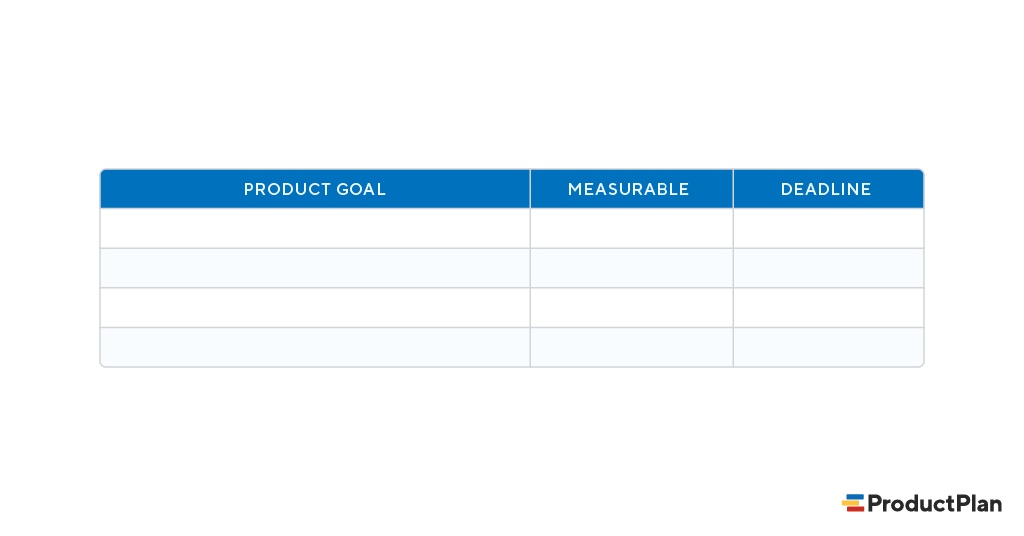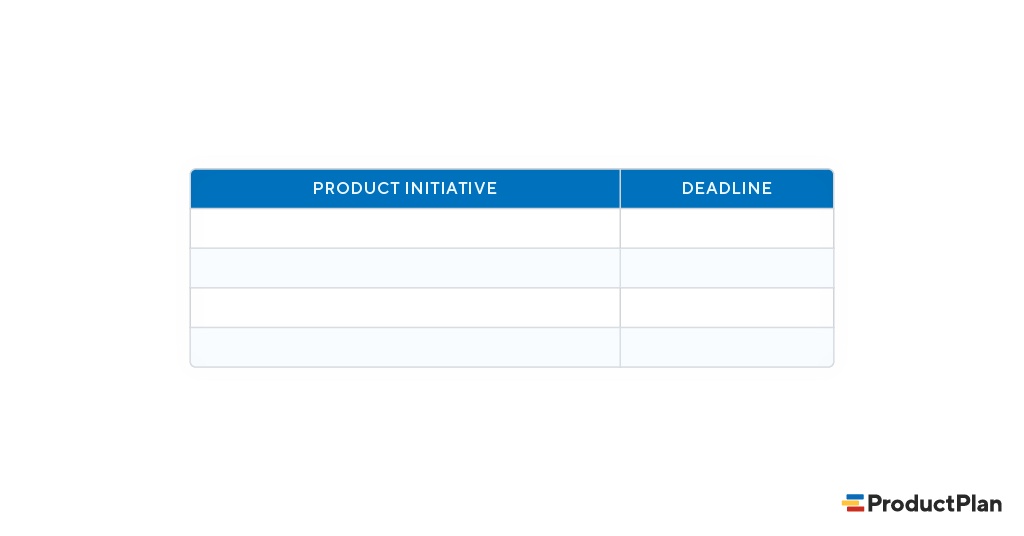What is a Product Strategy?
A product strategy is a high-level plan describing what a business hopes to accomplish with its product and how it plans to do so. The strategy should answer key questions such as who the product will serve (personas), how it will benefit those personas, and the company’s goals for the product throughout its life cycle.
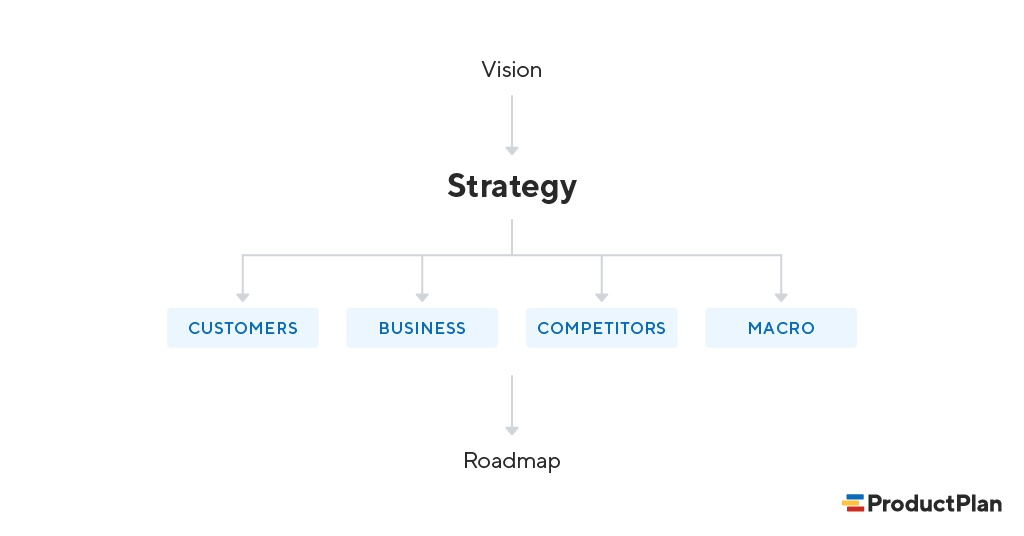 Why is Product Strategy Important?
Why is Product Strategy Important?
Building out a product strategy before you begin development is necessary because it serves three valuable business purposes.
1. A product strategy provides clarity for your company.
Your team will be in a better position to deliver their best work when you draft and communicate a clear and well-thought-out strategy for your organization.
Your developers will understand how the parts of the product they’re working on contribute to the larger companywide strategic goals. Developers can sometimes feel caught amongst all the details and lose sight of the overarching purpose behind their work. A product strategy clarifies that for them.
Your marketing and sales teams will be able to articulate the product’s benefits and unique selling proposition. However, without a defined strategy behind a product—generating anticipation and sales becomes difficult.
Additionally, your customer success team will better understand your product’s use cases and provide better support for your users’ frustrations.
2. It helps you prioritize your product roadmap.
After you’ve earned stakeholder agreement for your proposal, it will be time to translate that strategy into a high-level action plan and then build a compelling product roadmap.
Unfortunately, many product teams skip the strategy-drafting stage and jump right into listing themes and epics on their roadmap. Without a product strategy to guide these decisions, the team may prioritize the wrong items and find themselves misusing its limited time and resources. When you start with a strategy, you have a clearer picture of what you hope to accomplish with your product and translate it into a more strategically sound product roadmap.
Download The Product Roadmap Strategy Playbook ➜
3. A product strategy improves your team’s tactical decisions.
No organization delivers a product to the market following the exact plan drafted in the initial roadmap. Things change along the way, and product managers need to be prepared to adjust their plans and priorities to deal with those changes.
When you and your team have a clear product strategy as a reference point, you can make smarter strategic decisions about adjusting your plans, especially if you lose resources or need to change your estimated timetables.
A Product Strategy Template
Here is a template you can use to follow the three-step process above.
Define your vision.
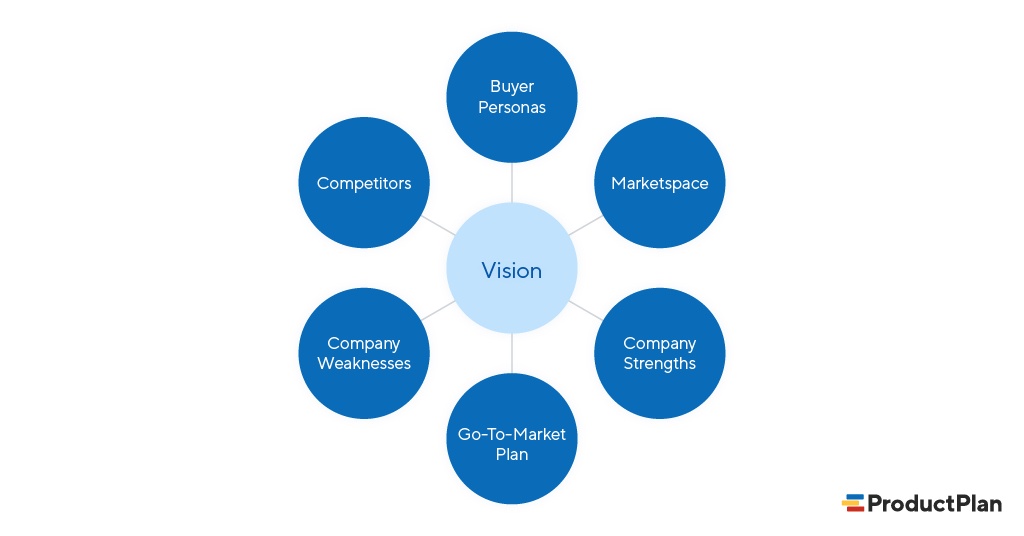
Add bullets to describe each of the outer circles above—competitors, personas, etc. During this exercise with your team, a picture should emerge of the problem you hope to solve for your market, for example, and the people and businesses it will help.
The exercise should help you develop a vision for your product.
Establish your product goals.
Next, add your goals for the product. For each goal, decide on a quantifiable way to track its success and set a deadline as well.
Create your product initiatives.
Now it’s time to translate your product goals into high-level themes that you can add to your product roadmap. Once they’re on the roadmap, your cross-functional team will review these themes, break them into detailed tasks, and begin working on them.
What are the Key Components of a Product Strategy?
Product management expert Roman Pilcher suggests a strategy should contain the following key elements:
- The market for the product and the specific needs it will address.
- The product’s key differentiators or unique selling proposition.
- The company’s business goals for the product.
Another way to understand this is that a product strategy should include the following three components:
1. Product vision
As we discussed above, product vision describes the long-term mission of your product. These are typically written as concise, aspirational statements to articulate what the company hopes the product will achieve. For this reason, a product vision should remain static.
For example, Google’s early vision statement for its search engine was, “Organize the world’s information and make it universally accessible and useful.”
2. Goals
A product vision should lead to high-level strategic goals. These goals will, in turn, influence what the team prioritizes on its product roadmap. Examples of product goals include:
- Increase free-trial downloads by 50% in the next 6 months
- Improve our average customer rating by one star on major product-review sites
- Generate $3MM in revenue within 12 months
Using SMART goals is the best approach to utilize when setting goals for your product strategy. Like product roadmaps, goals should be specific, measurable, attainable, relevant, and time-bound.
3. Initiatives
Initiatives are the strategic themes you derive from your product goals and then place on your roadmap. They are significant, complex objectives your team must break down into actionable tasks. (The product roadmap is, after all, only the high-level blueprint.)
Examples of product initiatives include:
- Improve customer satisfaction
- Increase lifetime customer value
- Upsell new services
- Reduce churn
- Add customer delight
- Break into new industries or geographical areas
- Sustain product features
- Increase mobile adoption
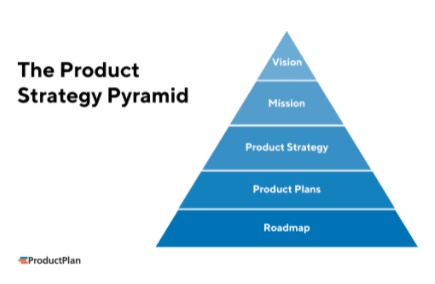
Where Does Product Strategy Fit in the Development Plan?
The product strategy should bridge your product vision and the tactical steps to fulfill that mission.
First, your team will develop the vision for the product. For example: “We will help businesses unlock valuable information by making their data more accessible and useful.”
(Note: Your team might also choose to draft a separate product mission at this stage. But product vision and mission are both concise, high-level statements conveying your big-picture aspirations for the product. You can create just one if you prefer.)
After you’ve settled on this vision, you can then work on the product strategy. This step will involve answering questions such as:
- Who are our personas for this product?(In the hypothetical above, the answer might include business analysts and database administrators.)
- What problems will our product solve for these personas?(One example: the product will allow users to easily combine data sets from multiple applications without having to convert formats or copy and paste.)
- How will our product differentiate itself and win the market?(We will give personas a visual interface, with charts and graphs, to help them make more sense of their data than they can with other tools.)
- What are our near- and long-term goals for this product?(Here, you might set a goal to sign up a certain number of users within the first two quarters after launch and to capture a percentage of the market within three years.)
After your team has built out the product strategy, it will be time to translate it into an action plan by prioritizing the major themes on a product roadmap.
You will then use this roadmap to build a detailed plan, including a product backlog, planning for the development team’s sprints, and developing a project timeline.
Learn how to align your product strategy with customer feature requests:
What Are Effective Product Strategy Business Models?
To this point, we’ve focused on the mechanics of developing a product strategy. What about the substance of the strategy? What types of business or revenue models should a company consider when coming up with its product strategy?
Here are a few examples of effective models for product strategies.
1. Product-led growth
We’ve written an in-depth article on how Zoom used the product-led growth (PLG) model to dominate during the pandemic. But here’s the bottom line: With the PLG approach, a business focuses on making the product its marketing and sales representative.
In many cases, such as with companies like Dropbox and Spotify, that means making the product free for a certain level of service and charging only users who want to upgrade to more advanced features. Because they find the basic service valuable, users tell their coworkers and friends, who also sign up for the product.
In other cases, businesses use the network effect to succeed with product-led growth. Companies like Slack and Zoom have benefited from this model. Zoom, for example, refocused its efforts early in the pandemic to make its app more user-friendly for the many new business users who needed it to connect while quarantined at home. The company also created features for new customers—notably schools—that would have unique needs.
2. Product segmentation
One product strategy proven effective by many companies—including Zoom—is to build different versions of a product to meet the unique needs of different personas.
For example, if you build apps for cybersecurity, you might choose to create a consumer version. The key selling feature of this app might be that it runs entirely in the background, protecting the user’s data and devices.
Your team might then build an enterprise version targeted at IT professionals, where your key selling points will be different. In this case, you will make sure the app makes it easy for businesses to comply with data privacy laws. You will also focus on building an administrator dashboard that gives the IT team a real-time view of its digital environment security.
3. The lean product differentiator
In the early days of the web, Yahoo! held the dominant position for an online search. But the company’s homepage was cluttered with links, buttons, and ads.
Then Google came along with a home page with almost no links, not a single ad, and comprised almost entirely white space. The only explicit following action on the Google homepage was to type in a search request. We know who won that competition.
One viable strategy is to release a product that lets users perform only a single task. The key is to ensure that 1) the task solves a real problem that your persona is facing, and 2) your product makes completing this task easy.
This strategy can work whether your product has competitors on the market (as Google did with Yahoo!) or you’re creating a new product category.
Suppose your product is easy to use and solves a real problem for your market. In that case, making the product as lean and focused as possible is a great strategy and a valuable product differentiator.
Related Terms
product strategy framework / product vision / product mission / product roadmap / product-led growth
